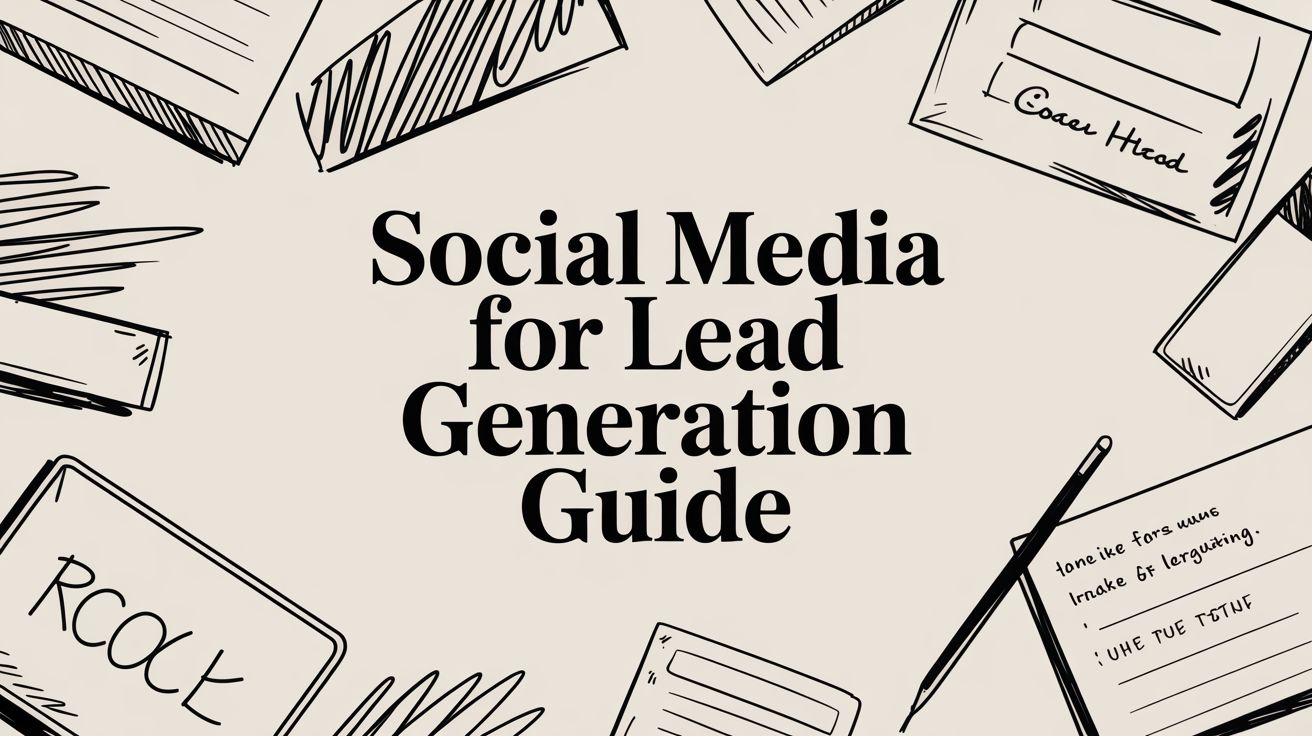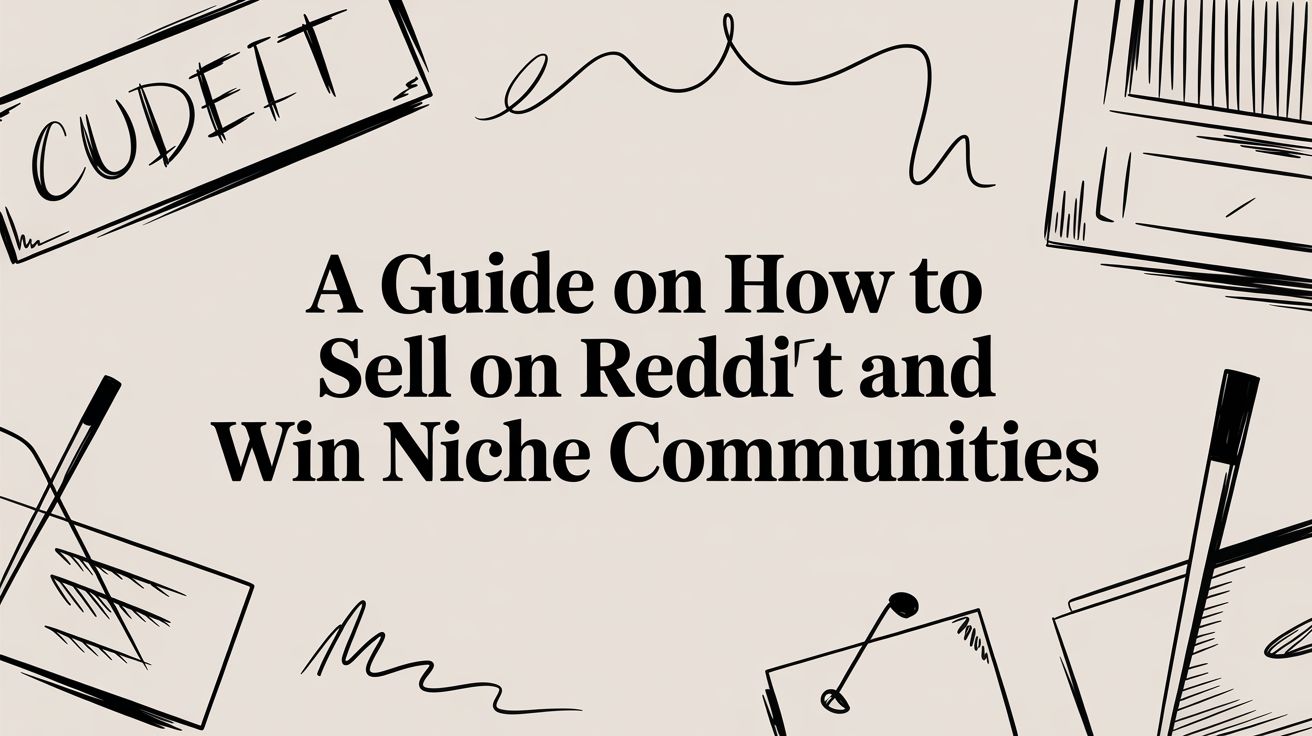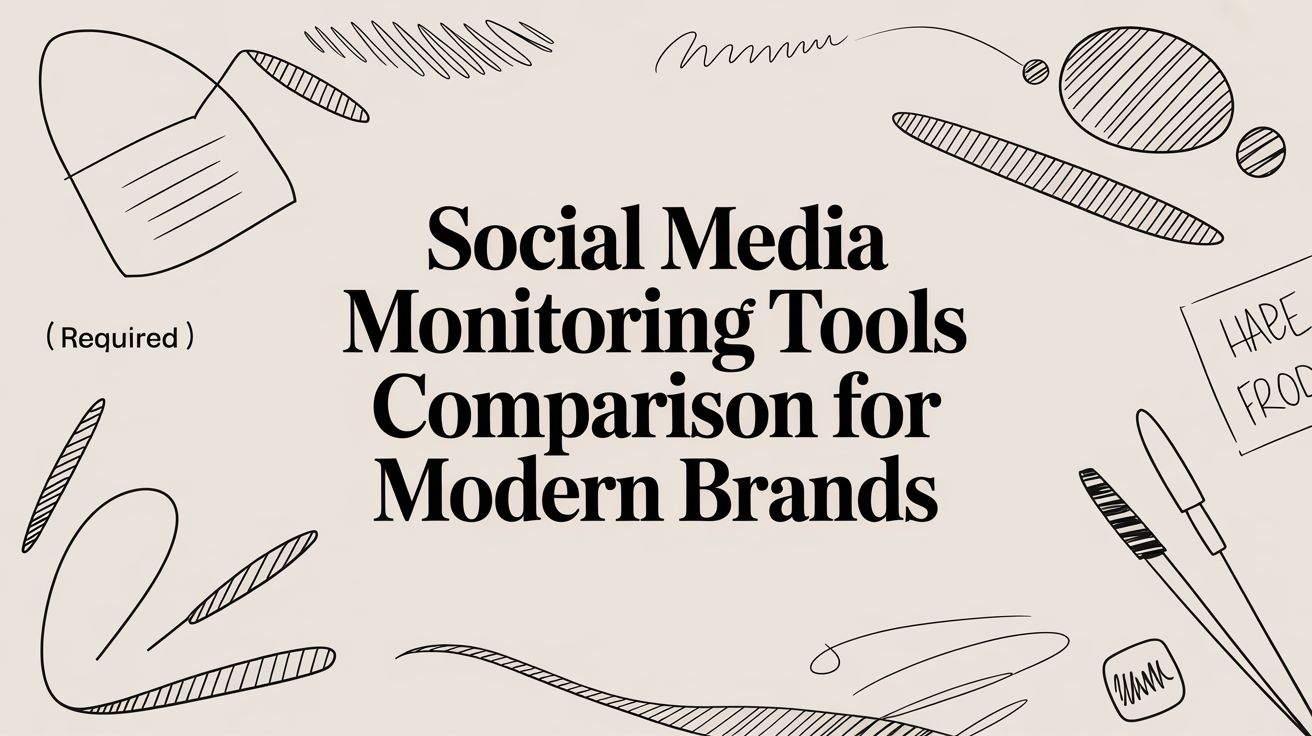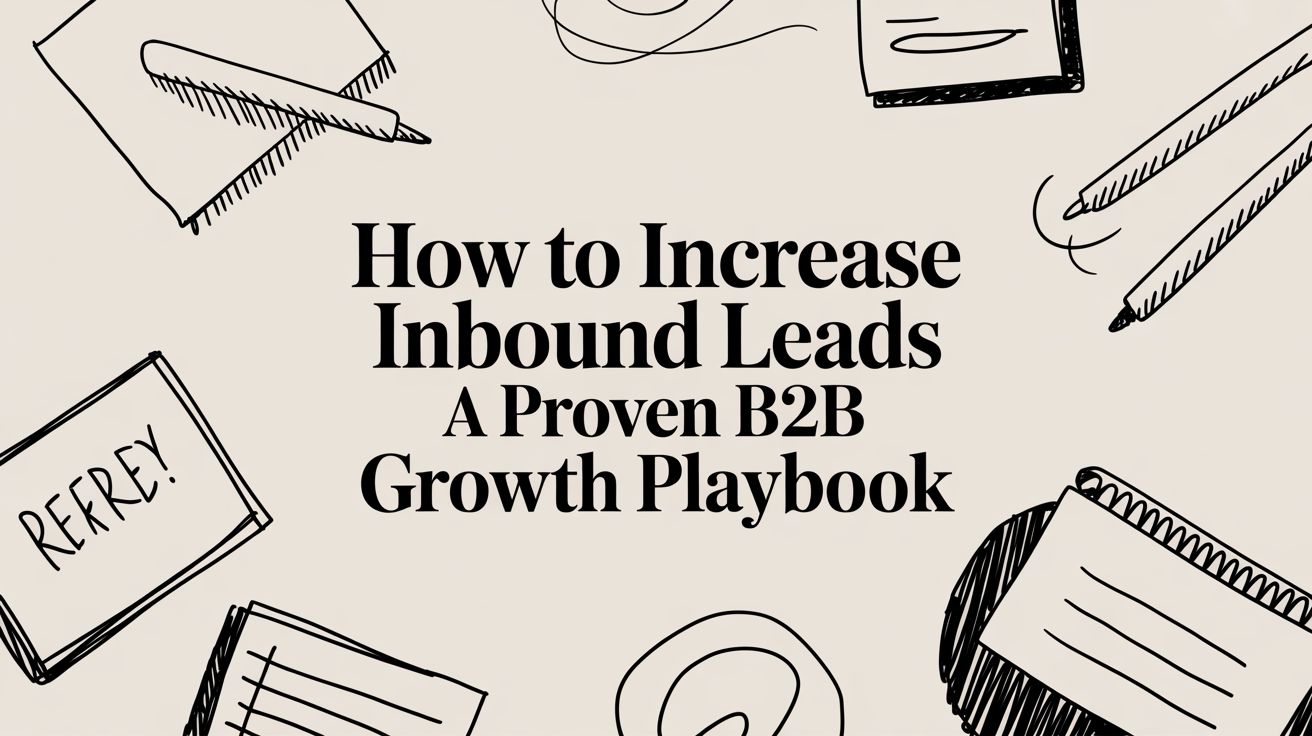Using social media to find new customers isn't just about collecting likes and followers. It’s about turning that online attention into real, tangible sales opportunities by strategically grabbing someone's interest and getting their contact info.
The real goal is to stop chasing vanity metrics and start building a reliable system that brings in potential customers, transforming your social media profiles from a simple billboard into a powerful engine for business growth.
Why Your Likes Are Not Turning Into Leads
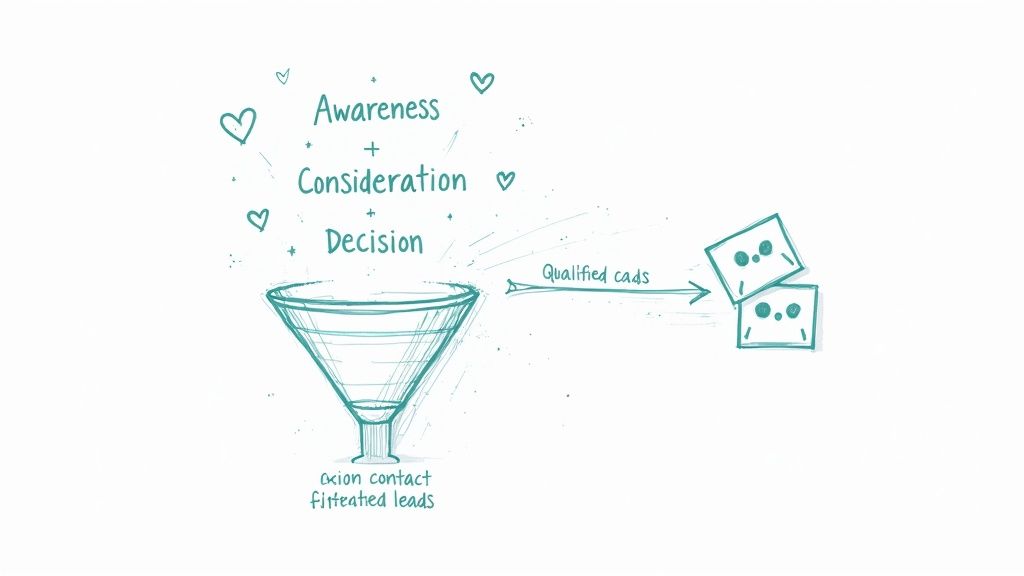
Let's be real—a post with a ton of likes feels great, but it doesn't directly pay the bills. This gap between engagement and actual business happens when companies use social media purely for brand awareness, not as a direct channel for generating leads. To really get to the bottom of this, you need to understand how to measure client engagement beyond open rates.
Think of the social media world as a massive, constantly flowing river of people. Brand awareness is like having a well-known boat floating on that river; people see it and recognize it. That's a start.
Lead generation, on the other hand, is about building a smart filtration system that pulls the right people out of that river and guides them toward your business. This isn't about just broadcasting messages; it's about creating a well-defined social media sales funnel.
Mapping The Social Media Sales Funnel
No one just shows up and buys. Every potential customer goes through a journey, and your social media plan needs to meet them at every step. This journey is often called a funnel, which has three main stages, each with its own purpose.
I've broken down this process in the table below, showing you how to think about each stage.
The Social Media Lead Generation Funnel Stages
| Funnel Stage | Primary Goal | Key Activities & Content | Metrics to Track |
|---|---|---|---|
| Awareness (Top) | Attract a broad, relevant audience and introduce your brand. | Educational blog posts, engaging videos, infographics, helpful tips, and entertaining content. | Reach, Impressions, Video Views, Follower Growth. |
| Consideration (Middle) | Nurture interest and build trust by showcasing your expertise and solutions. | Case studies, webinars, free guides, detailed product/service info, and live Q&A sessions. | Clicks, Post Engagement (comments, shares), Lead Magnet Downloads. |
| Decision (Bottom) | Convert interested prospects into qualified leads ready to talk or buy. | Testimonials, customer success stories, free trials, demo requests, and exclusive offers. | Conversion Rate, Leads Generated, Cost Per Lead (CPL). |
Mapping your content and interactions to these specific stages is how you turn passive scrollers into genuinely interested prospects. This structured approach makes sure every post and every comment serves a purpose.
By tailoring your content and interactions to each stage, you transform passive followers into qualified leads. This methodical approach ensures your efforts are focused on actions that directly contribute to revenue.
And it works. Globally, 66% of marketers are already generating leads from platforms like Facebook, Instagram, and LinkedIn. With Facebook alone giving you a potential audience of over 3 billion monthly active users, the opportunity is absolutely massive if you have the right strategy in place.
Building Your Strategic Lead Generation Funnel
Let’s be honest: throwing random posts at the wall to see what sticks isn’t a strategy. That’s just hoping for a miracle. A real social media lead generation plan is more like building a well-oiled machine—a funnel designed to carefully guide people from being casual scrollers to becoming genuinely interested prospects. This is how you stop broadcasting into the void and start creating a predictable engine for growth.
The entire system hinges on one thing: a deep, almost obsessive understanding of your Ideal Customer Profile (ICP). Too many businesses stop at the surface level—things like age, location, and job title. To actually make this work, you have to dig much, much deeper.
Think of yourself as a detective. You're not just getting a basic description of a person of interest; you're figuring out their motives, their habits, and what they struggle with every single day. What’s keeping them up at night? What are the specific headaches they face at work that your product or service could magically solve? And just as importantly, where do they go online to vent about those problems or ask for advice?
Defining Your Ideal Customer with Precision
To build an ICP that actually works, you need to answer questions that get to the heart of why people do what they do, not just who they are. This detailed profile becomes your North Star, guiding every piece of content you create and every platform you decide to spend time on.
Start by digging into these key areas:
- Pain Points: What are the top three frustrations they’re wrestling with in their professional life? A marketing manager, for instance, might be tearing their hair out trying to prove the ROI of their campaigns.
- Goals and Aspirations: What does a "win" look like for them? Are they aiming for a promotion, trying to make their team's workflow less chaotic, or under pressure to cut operational costs?
- Online Hangouts: Which specific LinkedIn groups, Reddit subreddunks, or X/Twitter hashtags are they actually active in? This isn't a guessing game; knowing this tells you exactly where to show up.
- Information Sources: Who do they listen to? Are there specific influencers, industry blogs, or podcasts they trust for real advice?
Answering these questions turns your ICP from a flat, cardboard cutout into a three-dimensional blueprint of a real person. This clarity is the difference between shouting into an empty room and starting a genuinely interesting conversation.
Creating Irresistible Lead Magnets
Once you have a crystal-clear ICP, you can build the most important part of your social funnel: the lead magnet. This is the valuable, no-strings-attached resource you offer in exchange for someone's contact information. Crucially, it’s not a sales pitch. It’s a generous act of help that directly solves one of their core problems.
The best lead magnets solve a small, specific problem for free. They build instant trust and show off your expertise. You want the person to think, "Wow, if their free stuff is this good, what can they do for me when I pay them?"
Great lead magnets are practical and easy to consume. Your audience is busy. They don't have time for a 300-page theoretical document; they need solutions they can put to work now.
Here are a few proven ideas for lead magnets:
- Checklists: A simple, step-by-step checklist for a complicated task (e.g., "The 10-Point Pre-Webinar Launch Checklist").
- Ebooks or Guides: A short, focused guide that goes deep on one high-value topic (e.g., "A Founder's Guide to Writing Cold Emails That Actually Convert").
- Webinars: A live or on-demand training that teaches a specific skill or strategy, cementing you as an authority.
- Templates: A ready-to-use template that saves them a ton of time and effort (e.g., "Social Media Content Calendar Template for SaaS Startups").
The magic is in the alignment. If your ICP is a startup founder struggling with outreach, a set of proven reply templates is infinitely more valuable than a generic industry report. For teams trying to scale their social engagement without sounding like robots, learning about a service like Replymer provides the human-powered solution they desperately need. Think of your lead magnet as the first handshake in a new relationship—make sure it's a firm and helpful one.
Mastering Channel-Specific Lead Generation Tactics
Trying to use a single, one-size-fits-all strategy for social media lead generation is like using the same key for every lock—it just won’t work. Each platform has its own distinct culture, its own set of audience expectations, and its own unique tools. To get real results, you have to adapt your tactics to the specific environment of each channel and learn to speak the native language of its users.
This means you need to ditch the broad-stroke approach and build a playbook for each channel. What grabs attention and drives action on LinkedIn will almost certainly fall flat on X (formerly Twitter), and tactics that feel normal on mainstream platforms can come across as intrusive and unwelcome on community-driven sites like Reddit. Understanding these nuances is what separates a frustrating, dead-end campaign from a successful one.
This map breaks down the core flow of any social media lead generation strategy, from finding your audience all the way to converting them into leads.
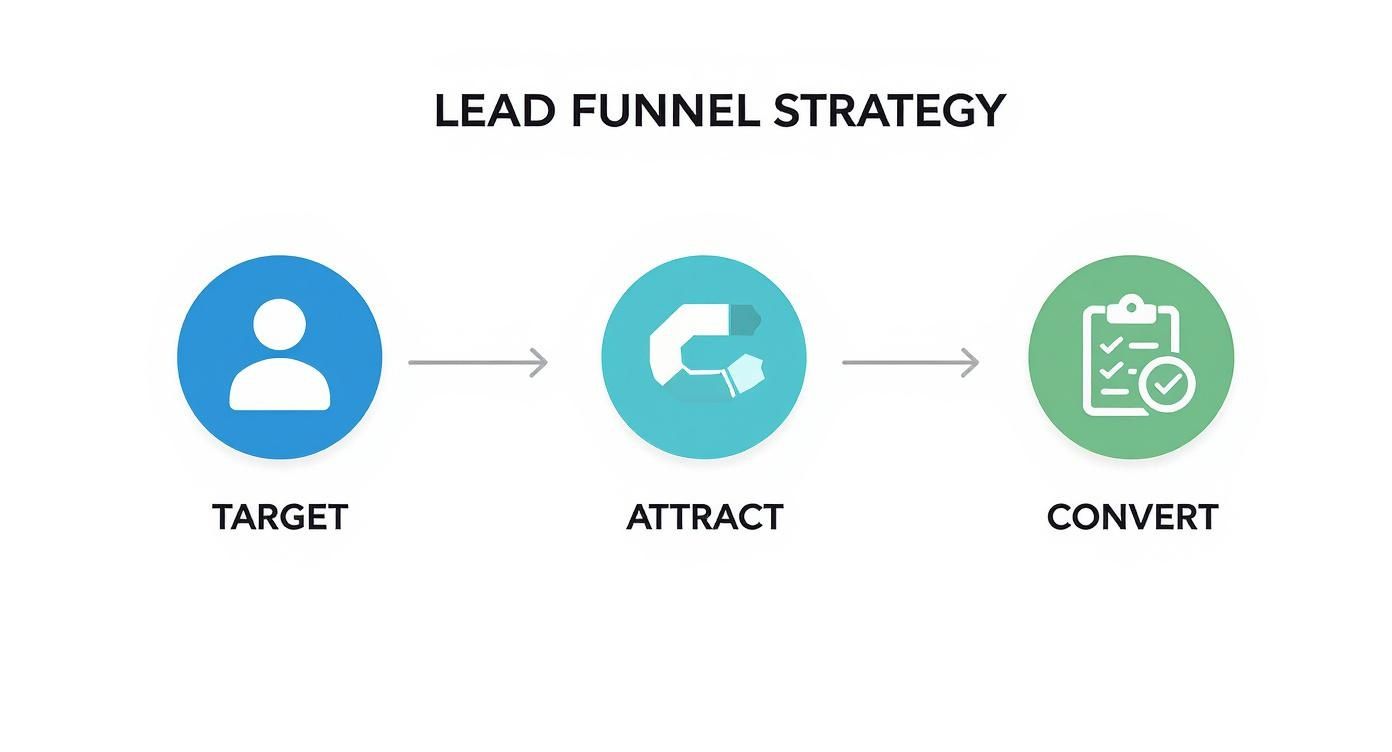
As you can see, no matter the platform, the fundamental steps of targeting, attracting, and converting stay the same. It's the how—the specific tactics you use—that changes everything.
The B2B Goldmine: LinkedIn
When it comes to B2B lead generation, LinkedIn is in a class of its own. The entire platform is built for professional networking, making it the absolute best place to connect with decision-makers. The trick is to treat it less like a digital resume folder and more like a massive, ongoing industry conference.
A surprisingly powerful (and often overlooked) strategy is to become an active, value-adding member of niche industry groups. Instead of just dropping links to your website, focus on answering questions, sharing sharp insights, and having real conversations. This approach positions you as a helpful expert, not just another salesperson, and naturally draws prospects to you.
For more direct outreach, LinkedIn Sales Navigator is a tool you can't afford to ignore. It lets you build hyper-specific lead lists based on criteria like company size, job title, seniority, and even recent job changes. This kind of precision ensures you're only spending your energy on your Ideal Customer Profile.
When it comes to B2B, LinkedIn is king. A solid 40% of B2B marketers rate it as their top channel for high-quality leads. In fact, 89% of B2B marketers use LinkedIn for lead generation, and 62% confirm it actually works for their business. Thanks to its advanced targeting, the cost per lead on the platform is 28% lower than on Google AdWords. You can dig into more data on LinkedIn's lead generation effectiveness on sproutsocial.com.
Driving Leads with X (Twitter)
X is all about speed, relevance, and getting to the point. Lead generation here isn't about lengthy posts; it's about jumping into conversations as they happen and offering immediate value. While posting your own content is part of the game, the real magic lies in proactive engagement and smart, targeted advertising.
One killer tactic is to use Advanced Search to find people who are actively talking about the exact problems your product solves. You can filter your search by keywords, negative keywords, questions, and even sentiment. This lets you pop into relevant discussions with helpful advice, building credibility long before you ever think about making a pitch.
If you want a more direct route, X's Lead Gen Cards are designed to capture info with almost zero friction. They look like regular tweets but contain a pre-filled form with the user's name, handle, and email. Offer something valuable—like a free template or an exclusive report—and you can collect leads right there on the platform, without making anyone click away to a landing page.
Here are a few ground rules for X:
- Do: Use relevant hashtags to get more eyes on your posts and join trending conversations.
- Don't: Automate generic replies to keyword mentions. It's spammy, and it kills your credibility.
- Do: Engage with industry influencers and thought leaders to tap into their audience.
- Don't: Turn your feed into an endless stream of promotional links. Stick to the 80/20 rule: 80% value, 20% promotion.
Tapping Into Niche Communities Like Reddit
Platforms like Reddit and Quora are built on a foundation of authenticity and community trust. If you come in with aggressive, sales-heavy tactics, you'll get called out and shut down in a heartbeat. To succeed here, you have to adopt a "give before you get" mindset, slowly building your reputation as a trusted resource.
Start by finding the right subreddits (on Reddit) or topics (on Quora) where your ideal customers hang out and ask for advice. For example, if you sell project management software, you’d want to be active in communities like r/projectmanagement or r/startups.
Your only goal at first should be to provide genuinely helpful answers and insights with zero expectation of getting anything in return. Share your expertise, offer detailed advice, and just be part of the conversation. Only after you've built a solid reputation for being helpful should you even consider subtly mentioning your product, and only when it’s a natural fit for someone's problem. This approach transforms you from an outsider trying to sell something into a valued community member offering a real solution.
Creating Content That Actually Converts
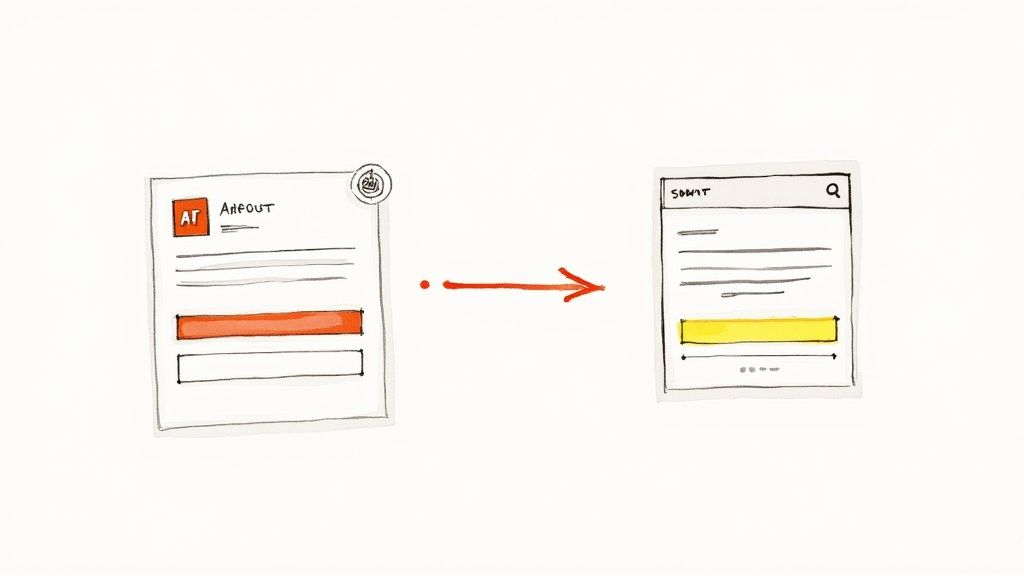
Knowing where your audience hangs out online is just the first piece of the puzzle. The real work begins when you have to create content that stops their scroll and makes them want to learn more. Let's be honest, generic company updates and bland promotional posts are just digital noise.
This is where you go from just being on social media to being genuinely valuable. It's a playbook for turning passive followers into active, interested leads. Every single post, reply, and interaction needs to have a purpose—to guide people one step closer to your business.
Crafting Posts with a Clear Call to Action
Every piece of content you share needs a job. Without a clear and compelling Call-to-Action (CTA), even the most brilliant post is a dead end. Think of the CTA as the bridge that connects someone's flicker of interest to the action you want them to take, whether that's visiting a landing page or signing up for a webinar.
Your content sets the stage, but the CTA delivers the punchline. A great CTA is direct, highlights a benefit, and creates a little urgency without sounding desperate. It tells people exactly what to do next and why it's worth their time.
Here are a few CTA formulas that consistently pull their weight on social media:
- Problem-Solution: "Struggling with [common problem]? Our free guide shows you how to [achieve solution]."
- Exclusive Access: "Grab the templates we use to [get amazing result]. Link in bio for instant access."
- Community Invitation: "Join our live webinar on [hot topic] this Thursday and learn how to [gain benefit]. Register here."
To really grab attention, you need headlines that pop. A powerful headline generator can be a lifesaver for crafting titles that make people stop and read, which is the first step to getting them to even see your CTA.
Building Relationships Through Authentic Engagement
Lead generation on social media isn't always a megaphone-style broadcast. The real magic often happens in the one-on-one conversations in the comments and Direct Messages (DMs). This is your chance to build actual human connections that translate into real business.
But your replies have to be real. A generic "Thanks for the comment!" is a wasted opportunity. A thoughtful response that adds a new insight, asks a follow-up question, or offers a helpful resource can transform a simple interaction into a meaningful conversation.
The most effective social media lead generation happens when you stop selling and start helping. Your goal in every interaction should be to provide value first, which naturally builds the trust required for someone to become a lead.
For example, if someone comments on your post about an industry challenge, don't just drop a link to your product. First, acknowledge their point and share a quick tip. Then you can say something like, "If you're interested, I have a resource that goes deeper on this." For more proven strategies on crafting these value-first replies, check out the resources over on the Replymer blog.
Using Interactive Content to Qualify Leads
Things like polls, quizzes, and live Q&A sessions are more than just engagement bait. Used smartly, they're a fantastic, low-pressure way to qualify potential leads and gather priceless insights about your audience.
A simple poll can tell you what people are struggling with. A well-designed quiz can segment your audience based on their specific needs. These formats work so well because they feel less like marketing and more like a conversation, making people eager to join in.
Here’s how to put these formats to work for lead gen:
- Polls: Ask questions that reveal pain points. A software company could post, "What's your biggest project management headache? A) Team communication, B) Hitting deadlines, C) Sticking to budget." The answers tell you exactly what kind of content or lead magnet to create next.
- Quizzes: Offer a short quiz that gives personalized results in exchange for an email. A marketing agency might create a "What's Your Social Media Marketing Score?" quiz. The user gets immediate value, and you get a qualified lead who's clearly interested in what you do.
- Live Q&A Sessions: Go live to discuss a topic your audience is passionate about. This positions you as the go-to expert and lets you answer questions from potential leads in real-time. It’s an unscripted, authentic way to build trust and prove your value. Just be sure to announce it ahead of time to build some buzz.
Measuring What Matters for Lead Generation
Running a social media lead gen campaign without tracking the right numbers is like flying blind. You might be busy, but are you getting any closer to your actual goal? Likes, shares, and new followers feel great, but they're what we call vanity metrics. They don't pay the bills or tell you if your pipeline is actually growing.
To prove the value of your work—and make smarter decisions—you have to zero in on the Key Performance Indicators (KPIs) that connect social media activity to real business results. These are the numbers that show you exactly what's working and what's just noise.
Core Metrics for Social Media Lead Generation
The real shift happens when you move from chasing engagement to measuring impact. This is how you build a predictable growth machine. These metrics are your new compass.
Here are the three most important KPIs you should be watching like a hawk:
Lead Conversion Rate: This is the big one. It's the percentage of people who clicked your social media link and actually filled out your form to become a lead. It’s the ultimate report card on your offer and landing page. A low rate is a red flag that your message is off or your landing page isn't convincing enough.
Cost Per Lead (CPL): This tells you exactly how much you’re paying to get a single lead from your social campaigns. You just divide your total ad spend by the number of leads you got. CPL is crucial for managing your budget and finding out which channels give you the most bang for your buck.
Lead-to-Customer Rate: This metric cuts right to the chase—it measures the quality of the leads you're generating. What percentage of the leads you got from social media ended up becoming paying customers? A high rate means you're attracting the right people. A low rate suggests you might be targeting the wrong audience.
Now, let's talk about how to track all of this. It's not enough to just look at overall numbers; you need to know where every lead comes from. Below is a table breaking down the essential KPIs you should have on your dashboard.
Essential KPIs for Social Media Lead Generation
| Metric (KPI) | What It Measures | Why It's Important | Industry Benchmark |
|---|---|---|---|
| Lead Conversion Rate | The % of visitors who become leads after clicking a social link. | Shows the effectiveness of your offer and landing page. | Varies by industry, but 2-5% is a common target. |
| Cost Per Lead (CPL) | The average cost to acquire one new lead from a campaign. | Helps you gauge budget efficiency and ROI on ad spend. | Highly variable; aim for a CPL that is <1/3 of your Customer Lifetime Value (CLV). |
| Lead-to-Customer Rate | The % of leads from social media who become paying customers. | Indicates the quality of your leads and the effectiveness of your targeting. | Aim for 10% or higher, but this depends heavily on your sales cycle and industry. |
| Click-Through Rate (CTR) | The % of people who saw your post/ad and clicked the link. | Measures how compelling your creative and copy are. | 1% is a decent baseline for many platforms, but this can fluctuate wildly. |
Keeping an eye on these metrics is the only way to truly understand what's resonating with your audience and what's falling flat. It turns guesswork into a clear, data-backed strategy.
Attributing Leads with Precision
So, how do you know for sure if a new lead came from your latest LinkedIn post or that ad you’re running on X? Without proper tracking, you're just guessing. This is where UTM parameters become your best friend.
UTM parameters are just little bits of code you add to the end of a URL. They don't change the page, but they tell your analytics tools exactly where the person clicking the link came from.
Think of UTMs as a digital breadcrumb trail. They let you trace every single lead back to the specific platform, campaign, and even the exact post that brought them to you. No more guessing, just knowing.
For example, a URL with UTMs can tell you that a lead came from a specific campaign (utm_campaign=spring_webinar) on a particular social network (utm_source=linkedin). This level of detail is a game-changer for optimizing your strategy and putting your budget where it will work hardest.
Optimizing Performance with A/B Testing
Once your tracking is solid, it's time to start improving your results systematically. The best way to do this is with A/B testing. It sounds technical, but the concept is simple: you create two versions of one thing—a headline, an image, a call-to-action button—and see which one performs better.
A structured approach to A/B testing allows you to make small, smart changes that add up to big wins over time. You can test the color of a button, the phrasing of your offer, or the image you use in an ad. This data-driven mindset takes the emotion out of marketing and lets you make decisions based on what your audience actually responds to, constantly refining your social media for lead generation engine.
Scaling Your Outreach with Smart Automation
https://www.youtube.com/embed/wqav2T_EUjE
So, you've got a social media lead generation process that’s actually working. Great! The next big hurdle is figuring out how to scale it up without losing the personal touch that got you here in the first place. Once you start growing, trying to manually handle every single comment, DM, and mention is a recipe for burnout.
This is where smart automation comes in. Think of it not as a replacement for genuine human connection, but as an amplifier for it.
It's a bit like being a great chef. Automation tools are your prep cooks. They're in the back, chopping the vegetables, measuring ingredients, and keeping the kitchen clean. This frees you up to focus on what really matters: perfecting the final dish and talking to your happy customers.
Choosing the Right Automation Tools
The whole point of automation here is to handle the repetitive, mind-numbing tasks so you can pour your energy into the high-value conversations. The right tools can help you wrangle your social media inbox, schedule content ahead of time, and, most importantly, flag those golden engagement opportunities that absolutely need a personal response.
Here’s what you should be looking for:
- Social Media Schedulers: Tools like Buffer or Hootsuite are lifesavers. They let you plan and schedule posts across all your channels, keeping your presence consistent without you having to be chained to your desk.
- Inbox Management Systems: These platforms bring all your DMs and comments into a single, unified dashboard. Nothing important falls through the cracks.
- Social Listening Alerts: These tools keep an ear to the ground for you, monitoring keywords and brand mentions. They’ll ping you the moment a relevant conversation pops up so you can jump in at just the right time.
The explosion of social commerce makes this more important than ever. A staggering 68% of marketers now say social media has directly increased their lead volume, largely because these platforms have dramatically shortened the journey from discovery to purchase. With more than half of users saying they’re open to seeing brand posts about products, the opportunity is huge. You can discover more insights about these 2025 trends to see how other businesses are getting ahead.
The goal of social media automation isn't to have robots talk to people. It's to clear your plate of the boring stuff, giving you more time and energy for the authentic, human interactions that turn prospects into loyal customers.
Maintaining Authenticity at Scale
Using AI-powered tools for outreach is a delicate dance. The secret is to use technology for personalization, not just for blasting out generic messages. For example, AI can be incredible at identifying potential prospects based on their online activity, but a human should always be the one to craft that first message to make sure it’s relevant, empathetic, and actually helpful.
One tactic that works really well is creating a library of response templates for your team. This keeps your brand voice consistent but still gives your team the building blocks to quickly personalize replies. When you get this right, automation gives you the superpower of being present and helpful everywhere at once, turning your scaled efforts into a true lead-gen machine.
And for those looking to scale their impact even further, you might be interested in our Replymer affiliate opportunities to help others grow their business.
Answering Your Top Social Media Lead Gen Questions
Diving into social media to find new customers can feel like trying to drink from a firehose. With so many platforms and so many "gurus" giving conflicting advice, it's easy to get stuck on the basics and never actually start.
Let's clear the air. We'll tackle the most common questions that trip people up, giving you the practical answers you need to get moving. Think of this as your pre-flight checklist—the essential stuff you need to confirm before you take off.
How Do I Choose the Right Platform?
The number one rule is surprisingly simple: go where your customers are. It’s a classic mistake to jump on the newest, shiniest platform when your ideal buyers are actually hanging out somewhere else. If you're selling enterprise software, you’ll find far more success on LinkedIn than on TikTok. It’s just common sense.
To nail down the right choice, run through this quick mental checklist:
- Know Your ICP: Where do these people go for professional advice? What online communities are they a part of? Who do they follow for industry news?
- Spy on Your Competitors: Which channels are your successful competitors using to get in front of their audience? That’s not a signal to copy them, but it’s a massive clue.
- Check Your Content Style: Do you create in-depth articles, quick-fire video tips, or professional case studies? Your content needs to feel at home on the platform you choose.
What Is a Realistic Budget for Social Media Lead Generation?
There’s no magic number here—your budget completely depends on your goals, your industry, and how fast you need to see results. You can absolutely generate leads with organic, non-paid efforts, but it’s a long game. Paid ads are the accelerator.
For a small business just dipping its toes in the water, a starting budget of $500-$1,000 per month for targeted ads on a single platform is a great way to test the waters. It's enough to see what messages and offers actually resonate with your audience.
A solid rule of thumb for a new campaign is to set a budget that gets you at least 100-200 clicks. Anything less, and you won't have enough data to tell if your ad, your targeting, or your landing page is the problem. It’s all about getting enough feedback to make smart decisions before you pour more money in.
How Can I Accurately Measure ROI?
This is where the rubber meets the road. If you can't measure your return on investment (ROI), you're just guessing. The trick is to stop obsessing over vanity metrics like likes and shares and focus on what actually drives revenue.
- Use UTM Parameters: These are little tracking tags you add to your links. They tell your analytics exactly which platform, campaign, and even which specific post brought in a lead. No more guesswork.
- Calculate Your Cost Per Lead (CPL): This is a simple but powerful metric. Just divide your total ad spend by the number of leads you generated. Now you know exactly what it costs to get a new prospect in the door.
- Track Your Lead-to-Customer Rate: This is the ultimate test of lead quality. You’ll need to work with your sales team on this one, but finding out what percentage of your social media leads actually turn into paying customers tells you everything you need to know about your strategy's effectiveness.
Ready to scale your social media outreach without sacrificing authenticity? Replymer uses real, human-written replies to find and engage qualified prospects on Reddit, X, and LinkedIn, turning online conversations into your most valuable lead source. Learn more at https://replymer.com.
